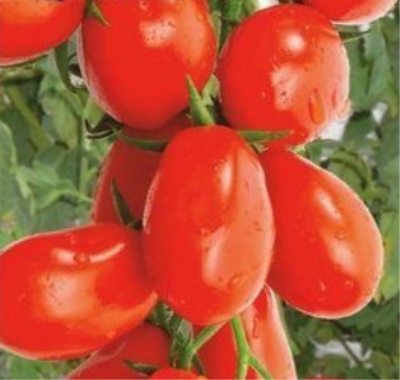
- Authors: Myazina L.A.
- Year of approval: 2010
- Category: hybrid
- Growth type: determinant
- Appointment: fresh consumption, for whole fruit preservation
- Ripening period: early
- Ripening time, days: 85
- Growing conditions: for film greenhouses
- Marketability: high
- Bush height, cm: 30-40
You can decorate a garden bed in the country or a window sill in an apartment with a decorative tomato bush by choosing a suitable variety of tomatoes, which will delight not only externally, but also with delicious fruits. An early maturing species of Cherripals will be suitable.
Breeding history
The Cherripalchiki tomato variety is the creation of the talented Russian breeder L.A. Myazina. The nightshade crop was added to the State Register of Breeding Achievements of the Russian Federation in 2010. Zoned mini-tomato in all regions of the country. The most productive variety when grown in film-type greenhouses.
Description of the variety
The cherry tomato is a determinant plant that grows to a height of 30-40 cm. The undersized bush is endowed with compactness, weak foliage, light emerald foliage, an erect central trunk and simple inflorescences. The first fruit cluster appears above the 6th leaf. On a healthy tomato bush, up to 10 clusters with 9-12 tomatoes in each are formed.
When growing an ornamental fruit variety, it is necessary to form bushes in 1-3 stems, and also tie up branches so that they do not break off under the weight of fruit brushes. Grassing and thinning of leaves is carried out at will. If you want to increase the mass of tomatoes, then you can leave 3-5 fruit brushes on the bush.
Cherripalchiks are characterized by a universal purpose, therefore tomatoes are eaten fresh, used in cooking, canned whole, pickled.
The main qualities of the fruit
Mini tomatoes belong to the small-fruited class. On average, a tomato gains a mass of 15-20 grams, however, under favorable conditions, vegetables grow up to 30-45 g. The length of tomatoes is 5-6 cm. The shape of the berries is cylindrical with a perfectly smooth surface. Ripe cherry is covered with a deep red color, and at the stage of technical maturity, the vegetable is light green. The skin of the fruit is shiny and firm, but not hard.
Tomatoes are characterized by resistance to cracking, they tolerate transportation well and are stored for a long time without losing their taste, useful and marketable qualities. Having removed the berries in an unripe form, they can be stored for up to 6 months.
Taste characteristics
Tomatoes taste excellent, despite their hybridity. The flesh of the vegetable is dense, fleshy and very juicy. The taste is dominated by sweetness, pleasant sugar content and light dessert aroma. The seeds in the pulp are practically not felt, since there are few of them and they are too small.
Ripening and fruiting
Early ripe tomatoes. From the moment of germination of sprouts to ripe tomatoes on the brushes, it takes less than 3 months - 85 days. The fruits ripen together, so the harvest can be removed with whole brushes. The fruiting process is prolonged, so you can enjoy delicious tomatoes for 3 months - from July to September.
Yield
The yield of the variety is impressive, despite the fact that the bushes are miniature. Observing all agrotechnical recommendations, you can grow from 2.8 to 3 kg of tomatoes per 1 m2.
The timing of planting seedlings and planting in the ground
Sowing seed for seedlings is carried out in early April. A special temperature regime of 22-29 degrees and a greenhouse effect, which can be achieved using glass or polyethylene, will help to improve seedlings. After 5-7 days, sprouts will appear. During this period, the room temperature should be reduced by 18-20 degrees.
Diving of plants is carried out at the stage of appearance of 2-3 true leaves. After the pick, useful fertilizers are applied. 10-12 days before transplanting, the plants begin to prepare - harden, taking them out into the fresh air. At the age of 55-60 days, the bushes can be transplanted to a permanent place of growth.

Growing tomato seedlings is an extremely important process, because it largely depends on whether the gardener will be able to harvest at all. All aspects must be taken into account, from seedbed preparation to planting in the ground.
Landing scheme
The method of placement and the density of planting tomato bushes are no less important than the agricultural technology of the plant. It is recommended to plant 3-5 bushes per 1 m2. Tomatoes should be planted according to the 40x60 cm scheme.

Growing and care
The variety is completely unpretentious in care, but has some requirements for the soil, which must be well fertilized. A favorable area is the area where cucumbers, radishes, zucchini and cabbage used to grow. A special culture does not require care, but basic measures are recommended: watering, feeding, weeding and loosening the soil, airing the greenhouse, garter and forming bushes, controlling moisture and protecting against insects and fungus.




A plant needs different micronutrients at each stage of growth. All fertilizers can be divided into two groups: mineral and organic. Folk remedies are often used: iodine, yeast, bird droppings, eggshells.
It is important to observe the rate and period of feeding. This also applies to folk remedies and organic fertilizers.
Disease and pest resistance
Tomatoes have genetic resistance to many nightshade diseases: Alternaria, late blight, root and apical rot, Fusarium wilting. Timely spraying with biological products will help protect from invasions of harmful insects.


Resistant to adverse weather conditions
The hybrid tomato is not afraid of a changeable or cool climate. It grows well and bears fruit with a short drought, and it tolerates heat. The main thing is to control soil moisture, a sufficient amount of light and air.

























































































